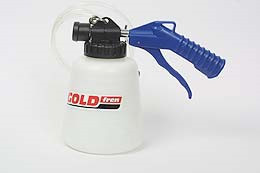How to bleed the brake system
Bleeding your brake fluid is a very important part when doing maintenance in the braking system. It’s essential that the brake fluid is kept in optimal conditions by performing regular brake fluid checks and exchanges. Air bubble infiltration in the fuild system occurs when there isn’t enough brake fluid in the brake system or after brake system dismantling. Any air bubbles present in the brake fluid greatly reduce brake pressure and braking efficiency.
It is essential to check the system´s condition before you start the bleeding procedure in order to avoid further complications (brake fluid leak from a cracked brake line etc.) If there is brake fluid leaking from the system, first take care of the leak and then move to the bleeding of your system.
When dealing with ABS equipped systems, remove the accumulator before your start the bleeding procedure. Never refill your brake system with an old used brake fluid because brake fluid can absorb moisture from the atmosphere vert easily and even a small miscroscopic impurity may cause brake system´s parts failure.
- Put your motorcycle on a straight pad, dismantle wheels (this is not obligatory, but wheels dismantling allows you an easier access to the bleeder bolts) and support your motorcycle with props.
- Clean area around the bleeder bolts to prevent any impurities getting in the fluid, replace the rubber caps from the bleeding bolts.
- Use a suitable ring spanner to loosen bleeder bolts and you will avoid the thread stripping.
- Fill the master cylinder with the correct brake fluid of DOT 4 class to the maximum and keep on checking the fluid volume while bleeding your brake system. You may need to need more brake fluid during the procedure. If the fluid volume drops under the MIN mark, you may risk new air bubbles infiltration.
- Before you start the bleeding proces, prepare a transparent pipe and fit it firmly to the bleeder bolt. Put the second end of the pipe into a container.
- Loosen the bleeder valves. The pressure in brakes decreases and as soon as the lever is weak and then tighten the bleeder bolt gently back up. Press the lever few times again and loosen the bleeder bolt again. In the meantime watch the fluid funning off the brake line.
- If there are any air bubbles running off the brake line, repeat this procedure until the brake fluid is bubble-free and clear.
- Handle the brake lever gently and slowly, do not press it too aggressively. If the master cylinder was exchanged as well, there should be short pauses between each lever pressure. It will allow the fluid to fill all the channels in the master cylinder.
- If the brake fluid running off the brake line is clear and bubble-free, you will be able to finally tighten bleeder bolts up, remove pipe, clean area around the bleeder bolt and put rubber caps back on the bleeder bolts.
- Use the same procedure for the rear brake.
- Check how the brake systems works after having it bled. Levers mustn´t be too flexible or weak. Their level should stay the same after couple of pressures. If you experience any of issues above, the brake system is not working properly (there are many reasons for this- air bubbles presence in the system, defective master cylinder or damaged piston sealing)
- Check if there is no liquid leak and make a testing ride in order to check your brake system.
Vacuum brake fluid bleeder – Part No. BO-507

